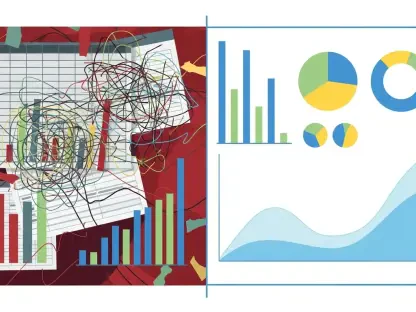The Power of Workplace Analytics in HR Decision-Making
Imagine a scenario where a company invests millions in a sprawling office space, only to find most desks empty on any given day due to hybrid work trends. This costly misstep highlights a critical challenge for HR leaders: making informed real estate decisions in an era of evolving work models. Workplace analytics has emerged as a transformative tool, enabling HR teams to shift from relying on intuition to embracing data-driven strategies that align physical spaces with actual employee needs.
The importance of this shift cannot be overstated, especially as hybrid and remote work arrangements redefine traditional office roles. Moving beyond gut feelings, analytics provides concrete evidence of how spaces are used, ensuring decisions reflect real-world dynamics rather than outdated assumptions. This approach is vital for optimizing investments in a landscape where employee presence fluctuates.
This discussion will explore several key areas: the dramatic change in workplace dynamics, the practical application of analytics in real estate choices, the diverse preferences of employees across generations and roles, and the need for financial accountability in justifying budgets to leadership. Each of these elements underscores how data is reshaping HR’s role in creating effective work environments.
Why Workplace Analytics Is a Game-Changer for HR
Navigating the complexities of modern workplace arrangements demands more than anecdotal insights; it requires a robust analytical foundation. With remote and hybrid models becoming standard for a significant portion of the workforce, understanding actual office usage is essential. Workplace analytics offers HR teams the clarity needed to make strategic decisions about space allocation and policy design in a rapidly changing environment.
The benefits of this approach are manifold. Analytics helps optimize space usage by identifying underutilized areas, enhances employee experiences through targeted in-office initiatives, reduces costs by minimizing reliance on external venues for events, and boosts retention by tailoring policies to specific needs. These outcomes transform the office from a static expense into a dynamic asset aligned with organizational goals.
Perhaps most crucially, analytics bridges the gap between perception and reality. Leadership may assume high office attendance, but data often reveals different patterns, enabling HR to align strategies with factual usage trends. This alignment ensures that real estate decisions support broader business objectives, making analytics an indispensable tool for forward-thinking HR departments.
Key Strategies for Implementing Workplace Analytics in Real Estate Decisions
For HR teams tasked with high-stakes real estate calls, leveraging workplace analytics involves a structured approach grounded in actionable strategies. The right data can illuminate patterns and preferences, guiding decisions that balance cost with employee satisfaction. This section outlines practical steps to integrate analytics into workplace planning, drawing on real-world insights and expert perspectives.
Implementing these strategies requires a commitment to data collection and analysis, paired with a willingness to adapt traditional models. By focusing on metrics that reflect actual behavior, HR can craft policies and spaces that resonate with the workforce. The following subsections provide detailed guidance on starting with basic data, reimagining office purpose, customizing approaches, and proving value to stakeholders.
Starting with Basic Metrics to Uncover Usage Patterns
The journey to data-driven real estate decisions begins with foundational metrics that reveal how employees interact with office spaces. Simple data points, such as badge scans and attendance tracking, offer a window into when and why people come to the office. These initial insights are critical for understanding peak times and identifying which departments or teams utilize spaces most frequently.
To build on this foundation, HR teams should establish consistent methods for collecting and analyzing data. This involves setting up systems to track entry and exit patterns, then reviewing the information to spot trends like high collaboration days or consistently empty zones. Such analysis helps pinpoint inefficiencies, laying the groundwork for smarter allocation of square footage and resources.
Case Study: Revealing Hidden Attendance Trends
Consider the experience of a large corporation that relied on badge data to reassess its office layout. Initial assumptions suggested uniform attendance across the week, but analytics uncovered that most employees clustered on midweek days for collaborative tasks. By realigning space allocation to match these patterns, the company reduced wasted areas and created a more efficient environment without additional investment.
Shifting to an Event-Driven Office Model
Traditional office models, where employees occupy desks daily, are giving way to a more purposeful approach centered on events. Transforming the workplace into a hub for team summits, cultural gatherings, and strategic meetings can significantly increase attendance. This shift redefines the office as a destination for connection rather than routine tasks, aligning with modern work preferences.
Analytics plays a pivotal role in this transition by helping HR plan events that maximize impact. Data on past attendance and engagement can inform the timing and nature of gatherings, ensuring they meet employee interests. Measuring outcomes post-event, such as collaboration levels or feedback scores, further refines this model, making the office a catalyst for meaningful interaction.
Real-World Impact: High Attendance Without Mandates
One organization achieved a remarkable 90% attendance rate for in-office events by prioritizing experiences over obligations. By hosting targeted workshops and social initiatives, the company drew employees back voluntarily, eliminating the need for expensive third-party venues. Analytics guided the selection of event types, demonstrating how data can drive engagement while controlling costs.
Tailoring Policies to Diverse Employee Preferences
Not all employees view office time through the same lens, as preferences vary widely based on generation, career stage, and personal circumstances. Analytics offers a way to segment these differences, revealing which groups value in-person interaction most and why. This understanding allows HR to design policies that resonate with distinct segments of the workforce.
A particularly effective strategy is positioning office attendance as a career growth opportunity rather than a mandate, especially for junior staff. Data can highlight how face-to-face time fosters mentorship and networking, which are often harder to replicate remotely. Crafting initiatives around these benefits ensures the office serves as a tool for development, addressing specific employee needs.
Example: Supporting Junior Staff Through Targeted Office Time
In one notable case, HR used data to create in-office programs tailored for early-career employees. By identifying that younger staff craved structured interaction for skill-building, the team scheduled mentorship sessions and training days, leading to higher retention rates. This targeted approach showcased how analytics can turn office presence into a competitive advantage for talent development.
Demonstrating ROI to Leadership Through Analytics
With workplace budgets under scrutiny, HR must justify real estate investments by linking them to tangible business outcomes. Analytics provides the evidence needed to connect office usage with metrics like productivity gains, employee retention, and cost efficiencies. This data-driven narrative is essential for gaining executive support in a climate of fiscal caution.
To present a compelling case, HR teams should focus on specific indicators, such as the success of in-office events or savings from optimized space. Visualizing how a moderate utilization rate balances energy with personal comfort can also sway decision-makers. These methods transform abstract expenditures into clear value propositions for leadership.
Success Story: Justifying Budgets with Data
A compelling example involved an HR department that used metrics to defend a space redesign. Data showed that a 40%-60% office utilization rate struck an ideal balance, fostering collaboration without overcrowding. Armed with this insight, the team secured executive approval for the redesign, proving that analytics can turn numbers into persuasive arguments for investment.
Final Thoughts on Harnessing Analytics for Workplace Transformation
Reflecting on the journey, it becomes clear that workplace analytics has redefined how HR approaches million-dollar real estate decisions. The ability to align office spaces with employee needs and business goals through data has proven transformative, turning potential missteps into strategic wins. This shift marks a new era where HR stands as a key player in organizational planning.
Looking ahead, actionable steps emerge for HR leaders eager to sustain this momentum. Investing in advanced HR tech tools with predictive capabilities stands out as a priority, offering the means to anticipate space demands and refine policies proactively. Integrating these systems with existing platforms also promises smoother execution of data-driven strategies.
Beyond technology, fostering a cultural shift toward natural collaboration patterns rather than forced attendance has shown lasting impact. Organizations embracing hybrid models, HR teams aiming for strategic partnership, and employees seeking meaningful in-office experiences all reap benefits from this approach. Addressing considerations like tech adoption challenges and cultural readiness paves the way for continued success in transforming workplaces.









